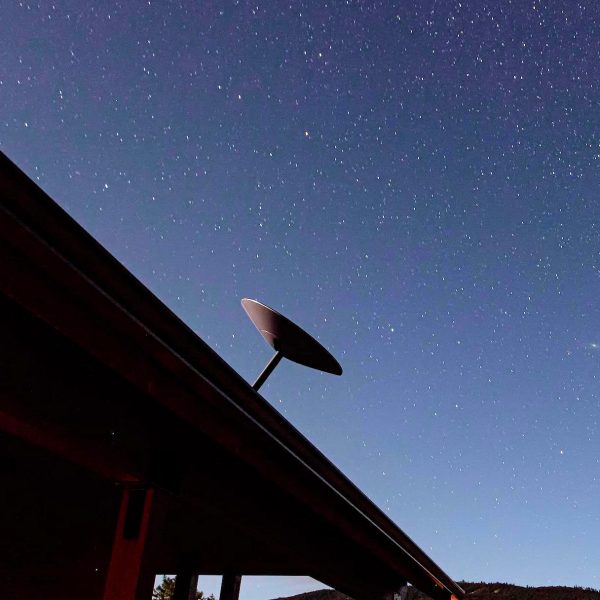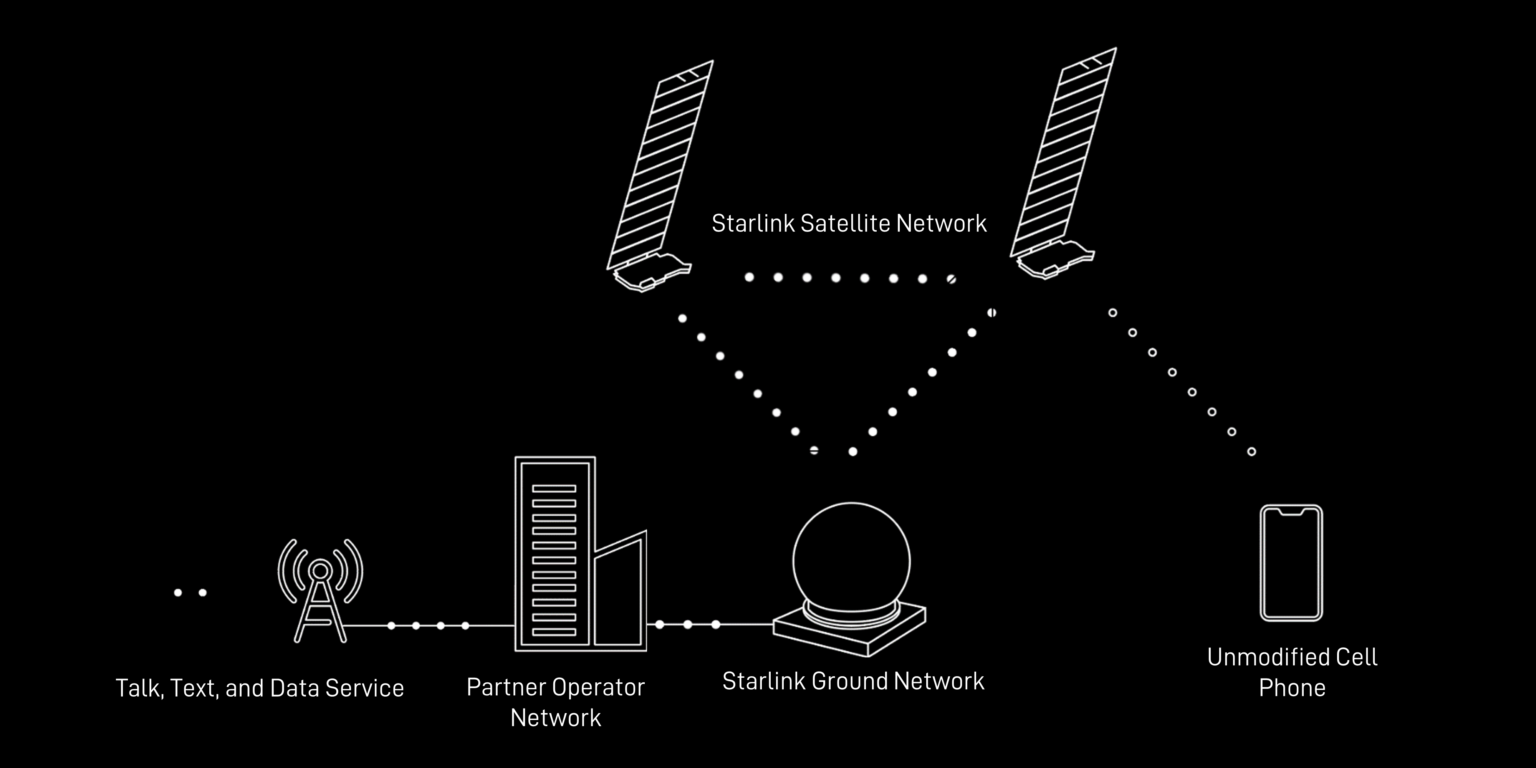Starlink Successfully Tests Space Direct to Cell Mobile Service

Starlink (SpaceX) has conducted the first successful live test of their new global Direct to Cell mobile roaming service with regular unmodified Smartphones, which came only six days after they launched (here) the first small batch of DtC capable broadband satellites. But at present it’s only being used to send and receive text (SMS) messages.
The operator’s network currently has around 5,311 LEO satellites in orbit around the Earth (altitude of c. 500km+) and they have approval to add roughly 7,500 more by the end of 2027. Customers in the UK pay from £75 a month, plus £449 for the home kit (standard dish, router etc.) and £20 for shipping on the ‘Standard’ package, which promises fast internet latency times of 25-50ms, downloads of c. 25-100Mbps and uploads of c. 5-10Mbps.
However, since 2022 (here and here) the company has also been busy working to add 4G mobile capability to their mega constellation of global satellites, which will make it possible to setup global roaming style communications with regular unmodified Smartphones on the ground. In the past, most satellite-based phone services were fairly basic and required bespoke and expensive handsets to function.
Advertisement
Satellites with Starlink’s new DtC capability instead have an advanced eNodeB modem onboard that acts like a cell phone tower in space, allowing network integration similar to a standard roaming partner. According to the latest update from Starlink, the first live technical test of this new capability officially took place alongside partner T-Mobile (using some of their radio spectrum frequency) in the USA on Monday 8th January 2024.
The test itself involved the sending and receiving of several text (SMS) messages, which were relayed between an unspecified Smartphone on the ground and their new DtC capable satellites in space.
Starlink Statement
On Monday, January 8, the Starlink team successfully sent and received our first text messages using T-Mobile network spectrum through one of our new Direct to Cell satellites launched six days prior. Connecting cell phones to satellites has several major challenges to overcome.
For example, in terrestrial networks cell towers are stationary, but in a satellite network they move at tens of thousands of miles per hour relative to users on Earth. This requires seamless handoffs between satellites and accommodations for factors like Doppler shift and timing delays that challenge phone to space communications.
Cell phones are also incredibly difficult to connect to satellites hundreds of kilometers away, given a mobile phone’s low antenna gain and transmit power. Starlink satellites with the Direct to Cell payload are equipped with innovative new custom silicon, phased array antennas, and advanced software algorithms that overcome these challenges and provide standard LTE service to cell phones on the ground.
SpaceX aims to launch a constellation of hundreds of DtC capable satellites to enable the launch of their basic text (SMS) service in 2024, with support for voice, data (mobile broadband), and Internet of Things (IoT) services due to follow in 2025 (although it wouldn’t surprise us if this slipped a little).

Advertisement
At present Starlink doesn’t have any mobile operators as partners in the UK, but the list of supporting operators has been slowly growing since the service was first announced. However, we still don’t know how much it will cost to add this kind of global roaming to an existing plan, which will need to be competitive with traditional roaming services if it’s to have any mass market appeal.
Furthermore, Elon Musk recently cautioned (here) that the first DtC capable Starlinks can only support data speeds of “~7Mb per beam and the beams are very big, so while this is a great solution for locations with no cellular connectivity, it is not meaningfully competitive with existing terrestrial cellular networks.”
Related documents released last year revealed that the Direct to Cell system will be able to provide “theoretical peak speeds of up to either” 3Mbps or 7.2Mbps peak upload (Earth-to-Space) over 1.4MHz or 5MHz bandwidth channels per beam, respectively, and up to either 4.4Mbps or 18.3Mbps on the downlink (Space-to-Earth) over the same bandwidth channels per beam using LTE (4G) technology.
In short, this is all about meeting basic communication needs across the globe and in remote areas.
Advertisement
Mark is a professional technology writer, IT consultant and computer engineer from Dorset (England), he also founded ISPreview in 1999 and enjoys analysing the latest telecoms and broadband developments. Find me on X (Twitter), Mastodon, Facebook, BlueSky, Threads.net and Linkedin.
« London UK Full Fibre ISP G.Network Discounts 300Mbps to £24






















































adsl started at a slow speed compared to what we have now.
having capability now and growing it is what will enable us to have truly global voice & data roaming in 5 years from a standard handset.
future vision leads to me think thats what was behind the mobile companies ditching their transmission networks.
maybe they will build a new one with 5g in the street lamps and 4g satellite backup in the hard to reach places.
not a great comparison.
the 1st gen ADSL equipment was always capable of more than what BT originally did with it, and indeed the “ADSL max” programme (up to 8Mbps down) was to simply remove those limitations.
Satellite systems meanwhile are not going to be able to beat the laws of physics. Starlink is to geo sat what VDSL is to ADSL – the faster speeds were only achievable by reducing the distance, not through any unforeseen leap in technology.
This isn’t going to replace traditional mobile networks, nor reduce the need for expanding rural coverage for most purposes.
@ivor
satellite phones have been a thing for a while and hove gotten smaller and smaller, satellite phone capability with a generic 4g phone is undeniably a huge evolutionary step..
lots of systems already use satellite comms for data, case in point is jet engines like those on on the mh370 777 that went missing, they still connected to imarsat for a period of time after contact with the flight was lost. Satellite comms is not novelty, satellite comms with a generic phone is.
Apple debuted emergency sos with the iPhone 14 released in September 2022, clearly well before these new starlink sats.
https://support.apple.com/en-gb/HT213426
compared to apples satellite implementation, 4g text message is a huge advance.
same handset but different provider capability, fits your example of adsl being more capable but needed bt to make changes their end.
18Mb on just 5mhz, is honestly not terrible and likely will improve over time. This would already enable able to use your phone like normal in the middle of the ocean (where there will be very few users per sat) or in a remote valley or other hard to reach land areas (where they are configured only to roam onto satellite if there’s no terrestrial connectivity on *any* network.
World wide phone calls using the same phones we’ve all got in our pockets is incredible.
“Apple debuted emergency sos with the iPhone 14 released in September 2022, clearly well before these new starlink sats”
Indeed I have had to use it once on my 14 Pro Max – really was a life saver
“World wide phone calls using the same phones we’ve all got in our pockets is incredible.”
Ones that don’t rely on the internet are.